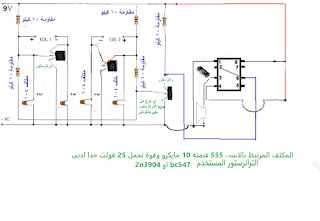If you want to make a simple and inexpensive metal detector with available tools and great depth, then you are in the right place.
This metal detector has a range of approximately 3 meters, and this depends on the ability to adjust the files.
Note: The images of the circuit and its printed files are from a purely Arabic production.
Pictures speak:
Here we can distinguish minerals by adding something simple to the circle, and through the picture it will become clear to you, God willing:
Parts required for the circuit:
They are very simple parts and are widely available in most electronic devices, such as old TVs and radios:
1 - Battery from 9 volts to 12 volts
2 - 220 micron capacitor 25 volts
3 - Capacitor 104 (100 nano), 9 pcs
4 - 10 kilo resistance, number 6
5 - Resistance from 39 to 45 kilos, number 2
6 - 1 kilo resistor, 1 piece
7: 1 impedance 2.2 megohms
8 - We use the same transistor, and we need 6 of them. Any one of these types will work efficiently, God willing:
& 2n5551& 2n5550 & 2n3904 & bc550 & bc549 & bc548 & bc547 & bc546
Dear brothers, it is possible to adopt any of the aforementioned types of transistors that will fulfill the purpose, God willing, and give a good result... When any metal approaches the large coil, a sound will be heard in the speaker. But how can we distinguish the metal here???
There is more than one method, but we summarize here some of the methods tested by me and my agencies:
We put a digital multimeter at the lowest possible size, such as 200 millivolts, and the two wires of the multimeter are connected to the collector of the fourth transistor and connected to the 39 kilometer resistance, which is next to the resistance of 2.2 megohms, and to the negative of the second or first transistor associated with the large or small coil.
When the sound approaches and comes into the speaker, the signal is loud and cannot be measured at 200 millivolts, but rusty metals have a negative sign, and the negative sign will appear before the sound appears, and therefore you will notice the sign, which is the approach of the signal to clean the wires.
Another way to identify minerals by sound is to use a file within a file
The small coil has a diameter of 15 cm and the large coil is 30 cm. The number of turns of the large coil is 12 turns, while the small coil has 118 turns. Here, the completion of the small coil requires several experiments to reach the whistle and balance the two coils.
In this way, ferrous metals have an intermittent sound, while non-ferrous metals have continuous beeps
لمزيد من المعلومات يرجى متابعة هذا الفيديو:







Comments